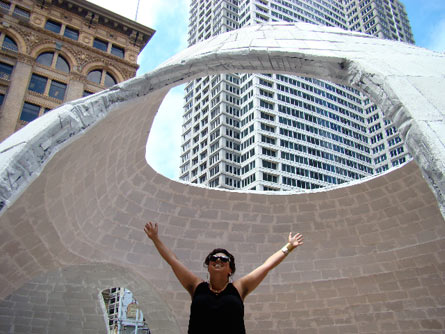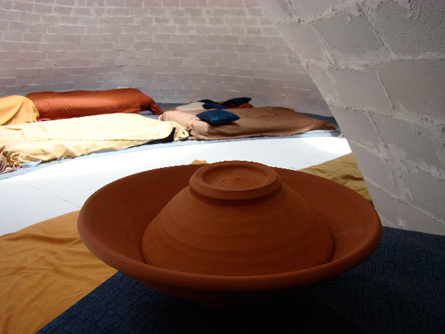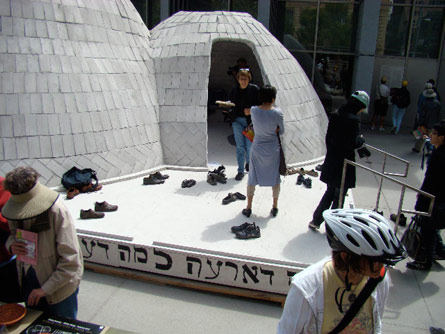The Secret Desires Of Babylonian Women Brought To Life Again
The Bowls Project: Secrets of the Apocalyptic Intimate
– an interactive sound sculpture/immersive performance installation based on Babylonian women’s amulets by Jewlia Eisenberg, at Yerba Buena Center for the Arts in San Francisco, California, USA through August 22, 2010.
Artist Statement by Jewlia Eisenberg
Photo: AnMarie Rodgers
What Is The Bowls Project About?
In late antiquity, Babylon was dense with supernatural beings. Seductive demons and fierce angels, jealous gods and powerful goddesses, all could be counted on to participate in everyday life, for good or for ill. These spirits could be coaxed and commanded with amulets containing special combinations of letters, repeated words, biblical prooftexts and esoteric images. The Bowls Project is inspired by texts drawn from demon bowls, amulets common from 300-700 CE in the area now known as Iraq.
Demon bowls, or incantation bowls, were inscribed with a householder’s secrets and desires and then buried under the doorway to protect her home. The requests found in the bowls are particular, yet timeless – calling for protection for children, health after miscarriage, release from gossipy neighbors, a loyal partner, a passionate lover. Divorce requests are common; often from people suffering from demons who married them non-consensually. A special delight of the bowls is to hear the individual voices of women from this time. These spiraled Aramaic inscriptions are among the few existing records of female voices during the time and place of the Babylonian Talmud.
The bowls inhabit the world of the “apocalyptic intimate” – a spirit-rich environment where the vast supernatural realm intersects the tiny domestic sphere. Bowls texts are also a fascinatingly cosmopolitan form, illustrating the porosity between Mesopotamian religions and cultures. Jewish bowls may host earlier Babylonian goddesses like Innana and Lamshtu, or borrow from Zoroastrian, Animist, Gnostic or proto-Islamic beliefs and practices.

Jewlia Eisenberg in one of the domes of the Bowls Project.
Why Did I Make The Bowls Project?
When I started this project, I was excited to offer participants a chance to interact with the very specific lives and concerns of the women whose voices we hear in the bowls texts. I first discovered these bowl texts in 2005. The US had invaded Iraq based on a pack of lies. Our occupation was killing and displacing millions of people, with a disproportionate affect on women and children. Yet most Americans, unless they had family in the armed services, barely gave Iraq a thought. Without telling people what to think, I wanted The Bowls Project to be a place where participants encountered their commonality to women living along the Tigris 1500 years ago. It’s easy to connect with the women of the bowls, since their preoccupations are much like our own. And if we share so much with them, how much more do we share with women who live there today? And how does that change the way we think about our relationship to what is happening in Iraq?
The Bowls Project allows participants to reflect on personal stories and discover the parallel stories of others. The music acts as a vehicle to reveal these vital ancient texts so that listeners can engage intellectually and sensually. The Bowls Project in the dome feels intimate and satisfying. It also opens up a larger discussion around the connections between material and literary culture, canonized and marginalized voices, ritual power and popular practice, and the ways music mediates these relationships.

The Bowls Project by Jewlia Eisenberg, installation view from inside the domes. The clay bowl is where people whisper secrets.
What’s Up With The Dome?
I knew that when I made The Bowls Project needed to be a place where people could enter into the world of these women’s voices. I wanted to make a space that echoed the physical shape of a demon bowl, with an interior that evoked the intimate concerns of the bowls texts. I also knew I wanted to inscribe the bowls sonically with both ancient and modern voices, musical, spoken, and ritual based. So that’s what is happening in the dome. It’s a double vaulted dome designed in collaboration with architect Michael Ramage. During the day, participants enter and are encouraged to whisper a “secret of the home” into a magic bowl. All over the rest of the dome they can hear the secrets of the home that others have shared. We harvest the sound files of all the secrets daily, and the new secrets are incorporated into the soundscape.
At night we play the settings of the ancient bowls texts that I composed, furthering the sonic inscription and the resonant conversation between voices from separate places and times. As part of The Bowls Project we have music and ritual taking place in the dome, with people who are exploring the themes of the project: The apocalyptic intimate, women’s voices, and embodied text.

The Bowls Project at Yerba Buena Center for the Arts in San Francisco, California, 2010.
What’s Up With Secret-sharing?
At its best, my work is a translation engine, opening up a hybrid space where connections can be drawn between divergent experiences, without erasing individual identities. Shifting between text and music, between verbal and non-verbal languages, between personal and communal expression in ancient and modern experience — I feel this allows for something to be gained in translation, rather than lost. The secret-sharing piece of The Bowls Project is an important part of that.
The bottom line is to make a space where people separated by boundaries – physical, cultural, temporal – can take intuitive leaps towards each other. The best we can hope is to become part of each other’s stories. We encourage anyone who cannot visit the dome to share their secrets of the home at the Bowls Project website.
About Jewlia Eisenberg
Out artist Jewlia Eisenberg is an interdisciplinary artists and founder of the diaspora girl group Charming Hostess. Born and bred in Brooklyn, New York, she now calls Oakland, California home. Her work explores the intersection of text and the sounding body, pushing for translation strategies between verbal and non-verbal languages. CDs include Sarajevo Blues, which sets Bosnian resistance poetry, and Trilectic, a look at the political-erotic world of Walter Benjamin. Jewlia is now presenting The Bowls Project, a large-scale installation based on magic and sex in Babylonian Jewish amulets.